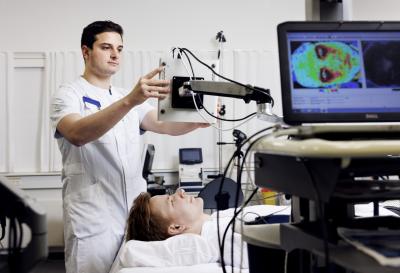Håkan Ashina
Long-term effects of concussion
Håkan Ashina, doctor and PhD student, is receiving a Lundbeck Foundation Talent Prize for his research on post-traumatic headache.
Concussion gets better with time, or does it?
Luckily it does – after a brief period with headaches after the event that caused the concussion, for example after falling off your bike.
However, up to a third of those affected by concussion are still suffering three months later, and the headaches are accompanied by cognitive impairment, insomnia, sensitivity to light, nausea and symptoms of anxiety or depression.
‘If you feel like this three months after a concussion, you’re suffering from posttraumatic headache – a condition that’s extremely difficult to treat,’ Håkan Ashina explains.
Ashina is a doctor and PhD student at the Danish Headache Centre and the Department of Neurology at Rigshospitalet, University of Copenhagen, and he is one of the recipients of a 2021 Lundbeck Foundation Talent Prize.
‘One of the reasons why persistent posttraumatic headache is difficult to treat is that the medical profession is only now beginning to gain a systematic understanding of the disease presentation and the biological mechanisms underlying the condition,’ Ashina explains.

Together with his research colleagues at the Danish Headache Centre, he has studied the similarities between persistent posttraumatic headache and migraine: ‘Because, although these are two completely different disorders, they have several common traits,’ says Ashina.
The research team at the Danish Headache Centre therefore decided to conduct a trial involving the CGRP neurotransmitter. The aim was to see if it would be possible to trigger migraine-like headaches in individuals suffering from persistent posttraumatic headache.
CGRP is a neurotransmitter in the brain able to induce migraine – and this knowledge has led to the design of so-called CGRP inhibitors. These are state-of-the-art drugs with only few side effects. They help rid many migraine sufferers of the debilitating pain and enable them to live an active working and family life.
‘Our study was based on the theory that if CGRP can induce migraine-like headaches in patients with persistent posttraumatic headache, these patients may benefit from treatment with CGRP inhibitors,’ Ashina explains.
When the results of the study were in, they indicated that there was a basis for this assumption. The monthly incidence of moderate to severe pain caused by persistent posttraumatic headache was at least halved in 28% of the participants.
These results are below the efficacy rate observed when migraine patients are treated with CGRP inhibitors. ‘But this could be because treatment needs in the case persistent posttraumatic headache are more complex than for migraine, because several other symptoms are also involved. This is what I’ll be studying further,’ says Håkan Ashina.
